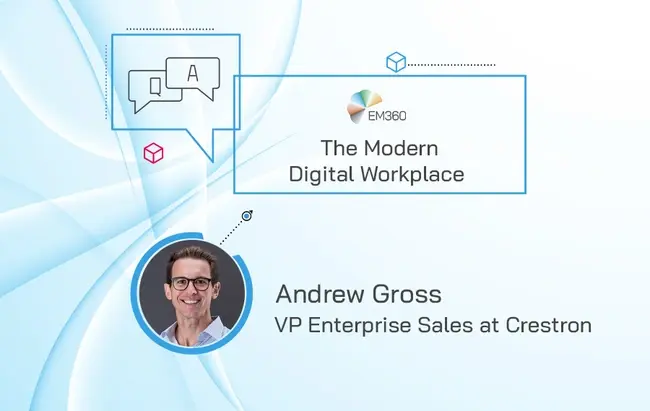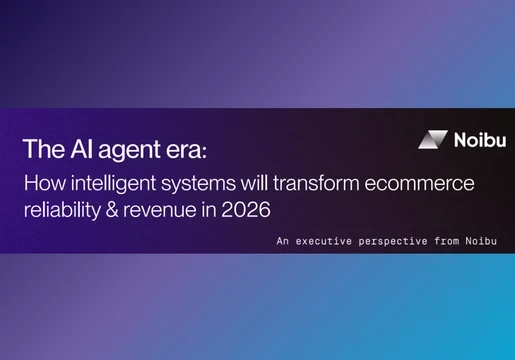With the UK vaccine roll-out in full force and the thought of returning to the office becoming reality, one question on every business owner's mind is ‘How do I go about adapting the workplace to make my employees feel safe and at-ease?’. Traditional, pre-COVID office customs such as handshaking, company-wide cramped conferences, and back-to-back desks can no longer operate today. Organisations need to re-configure and optimise their spaces - especially when employees return in full, whilst ensuring that the key attributes that make-up office culture - i.e. collaboration and connection - are still feasible.
One enterprise that is supporting businesses through this tricky transition and transformation is Crestron. The leading innovator and manufacturer of advanced corporate control and automation systems is providing business leaders with integrated IT solutions to the current, seemingly overwhelming, challenge of COVID-19-induced workplace adaptation. Joining us in this week’s QnA to reveal more about their approach is Andrew Gross, VP of Enterprise Sales at Crestron. Andrew has worked at Crestron for over nine years, specialising in enterprise - namely unified communications - solutions within the company’s sales department.

Welcome to EM360 Andrew! Can you start by telling us how you came to work at Crestron and why you decided it was the ‘place to be’ and, ultimately, the place to build an enterprise solutions-based career in?
As the way most things in life occur, the beginning of my career was mainly shaped by coincidence. Progressive insight did the rest. I started at Crestron right out of Penn State University, where I graduated as a nuclear engineer. Originally, I intended to work at a nuclear power plant because I was fascinated by energy management, but then there was a job fair where Crestron was present. I learned that they had an energy management engineering department where, amongst others, motion sensors, light sensors, partition sensors, and lighting and energy management measuring equipment was created. I wasn’t active in the AV industry, so I hadn’t heard of the company before, but since then I truly believe that it is even more important to save energy than to create it. Hence, I decided to give Crestron a shot; especially after I did some research and learned how innovative they are.
After a couple of years working as an engineer in the energy management department, I realized I wanted to talk to customers about what I was making and listen to their needs. Luckily, Crestron gave me the opportunity to make that transition. So, for the next couple of years, I talked to people at various companies, government organizations, and schools all over the world and helped them lower their energy bills and meet their energy codes. It was through these conversations that I realized there was more to engineering than just lighting and energy control. I discovered that the biggest wave of change could be made by rethinking how we collaborate remotely and conduct video interviews, so I began immersing myself in collaboration, video and audio distribution, cable management, and cloud-based control, as part of the Enterprise Sales department.
In 2018, me and a couple of other people at Crestron began building the UC Enterprise team. Our sole focus was video collaboration and how Crestron can offer the hardware platform for Microsoft Teams, Zoom, and other collaboration software providers within the enterprise. Thus, Crestron Flex was born. We started with a team of two in the U.S. and now have 40 UC employees all over the world. Each of them is a trusted advisor in the future of work.
The pandemic sped up the demand for enterprise solutions. It made every organization take a closer look at their remote and video collaboration experience, and thanks to Crestron’s reputation, established by delivering highly innovative and reliable products for over 40 years, the company is becoming the standard in enterprise solutions.
What does it mean to be a modern, digital workplace in the era of COVID-19?
Covid-19 has accelerated a change that was already ongoing – the one towards activity-based work, where people decide where they work based on the type of work they have to do. Nonetheless, the office did not become irrelevant. Face-to-face contact with colleagues increases the effectiveness of our roles and is essential for our mental health. The workplace is also critical to innovation. Being together physically enhances our ability to stimulate thoughts. That said, offices have to offer added value in order to convince employees to come back and it is interesting to see the different approaches companies are taking.
Digital transformation is driven by people's urge to push and expand the limits of what current and future technologies make possible. By 2025, millennials will make up 75% of the workforce and their changing expectations of what an employer and workplace have to offer will force companies to rethink the way they look at technology and how they use it.
Despite this, the pandemic technology has become not just parallel to our working lives, but fully integrated. Pre-pandemic, technology lived very parallel to our working lives. We had a separate, dedicated phone that we would use to call colleagues and partners, a conference room for meetings, and a desk to work from. Now, the modern, digital workplace lets you do all of that wherever you want. It has blended everything and integrated technology everywhere so you can work from anywhere.
How is technology strategically shaping and changing workplace design and what role does Crestron play in this?
These past months will surely go down in the history books for many reasons, but no one can overlook the transformative impact the pandemic has had on the way we collaborate and connect. If businesses hope to stay competitive, keep their workforces productive, and pursue their goals, innovation and technology are an absolute necessity. Crestron has been shaping a smart workplace and smart living with cutting-edge solutions long before it became a necessity. Delivering technology that can help and contribute to the ease, efficiency, and comfort of us all, everywhere, is what we do.
The increasing possibilities offered by the smart integration of technology are changing the expectations. Companies are starting to realize that the sky's the limit on the road towards truly smart and connected buildings. For instance, because of the rise of hybrid working, adding video conferencing and collaboration technology to every space, large or small, is now a requirement. So obviously, they should all include great audio quality cameras that capture everyone in the room, plus an easy way to control the technology and start a meeting. Although a hybrid workforce means that you don’t know in advance where people will be (remote, in the office, traveling?), which means that you need a very intelligent way to manage the rooms in your office, so you can release rooms when nobody enters. Smart room management, based on sensors, is the answer here. At the same time, the current focus on a safer environment is here to stay. This means that people in the office expect a touchless experience. Air quality control and automatic adaptation doesn’t only keep people safe, cleaner air is also associated with increased wellbeing.
These past few months have also created a unique situation for AV, UC, and IT managers. The rate at which companies introduced new technology to their workforce, and the rate at which new and existing technology was adopted by the workforce for professional and private use, is unprecedented. In spite of this, when you introduce more new technology in the workspace, you are bound to see more issues. Just think of all the extra potential failure points, the questions inexperienced people will have, and the extra training they will need.
Luckily at Crestron, we have extensive experience with remote control and management through XiO Cloud - an Internet of Things (IoT) based platform that enables you to remotely provision, monitor, and manage devices across an enterprise or an entire client base. XiO Cloud services facilitate daily management and monitoring of every device through a single dashboard with comprehensive reporting and logging, live status viewing and alerts, performance metrics and analytics, scheduled actions and updates, people counting, and more. As requirements grow and evolve, new features and functionality can be added easily to one or many devices at any time without ever going on-site. The addition of remote desktop capability empowers technology managers to provide better and faster support via the timesaving IoT-based provisioning service.
At last year’s Integrated Systems Europe event, Crestron spoke about some of the digital workplace trends, one of them being corporate automation technology. Why do you think this is ‘one to watch’, especially considering the COVID-19-induced workplace adaptation challenge that businesses are facing today?
First of all, during the past 15 months, every worker in every department became much more technology savvy. Today, everyone is an expert in joining meetings and expects at least a basic level of AV quality. So, our customers have a different level of expectations than they did a year and a half ago. Secondly, since COVID-19, there is an increased demand for a touchless experience. We used to press a button to call someone, turn on the lights, and close the shades, but now we would rather avoid touching communal objects.
Corporate automation through artificial intelligence (AI) is part of the answer here. AI can help automate how your space reacts, increase your wellbeing, and even make the room more efficient. If AI can learn my preferences, it can make my job simpler and more efficient, and increased efficiency means more money. On the other hand, increased wellbeing makes employees feel more comfortable and more welcome. Automation technology not only makes the digital workplace a safer experience; it also makes it more exciting. How cool is it to walk into a room and the room recognizes you and how you like the shades at 50%, lights at 80%, and heating at 21°C/70°F? These kinds of things make your life better and make you a happy employee.
As offices reopen, should the enterprise still prioritise the cloud-based operation model? If yes/no, why?
Yes, because a cloud-based operation model reduces the cost of ownership. I like to compare it a bit to the rise of electricity. In the beginning, every factory had its own generators because that was just the way it worked. But gradually, we evolved and today we rely on power plants and the abundancy that comes with it. I see the same happening with the switch from Ethernet to the cloud. We didn’t have a choice in the beginning and Ethernet absolutely had its benefits, but those are now being outshined. The cloud offers massive processing power and built-in security. For a lot of companies, the security through cloud is a lot more extensive than their Ethernet lines.
To round up: many business leaders will be putting together a return to the office plan of action. In your opinion, what do organisations need to consider and include in their strategies?
Before COVID, only 20% of meeting rooms were video-enabled. This is quickly changing with hybrid work becoming more dominant and adding video conferencing and collaboration technology to every space, large or small, is now a requirement. These should all include great audio quality cameras that capture everyone in the room and an easy way to control the technology and start a meeting.
All users should have a consistent collaboration experience at all times. No matter which room they are in at the office or at home. By giving remote users access to the same level of technology as they would have at the office, you are not keeping them at home, but you are keeping them connected. Using the right technology, for instance an intelligent desk phone, also helps battle the meeting-fatigue that everyone has experienced. More meetings are happening than ever before – in the last year, meeting time has more than doubled for Microsoft Teams users to 148% and continues to rise. Simply offering a laptop with built-in webcam doesn’t suffice anymore.
Of course, every room needs to be video enabled. How do we democratize the video conferencing experience? How do we make sure that people in the office have the exact same experience as those working from home? We are expecting some exciting, groundbreaking technology in the meeting space that Crestron will support to better mimic what we were able to get when we are at home. By providing individual and/or specific video framing for all participants, whether at home or one of six in a conference room, we can provide everyone the same first-class experience as we get from our home offices and our kitchens. Remote people are no longer second-class participants in the meeting. When you get cropped by an intelligent camera that zooms in on your face, you are more present than the six other people that are physically in the meeting room. Your body language is more visible instead of less and usually the display showing the remote participant(s) is in the center of the room. Soon, we will be able to streamline the experience and your presence, no matter where you are.







Comments ( 0 )